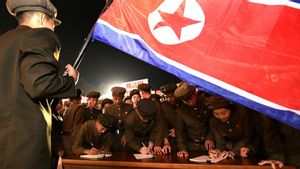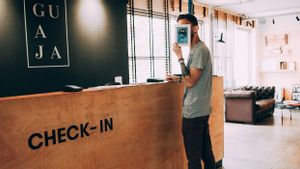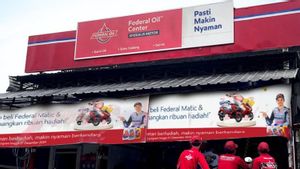YOGYAKARTA - Head of Bank Indonesia Representative for the Special Region of Yogyakarta, Budiharto Setyawan, revealed the cause of DIY being the poorest province on the island of Java according to the Central Statistics Agency (BPS).
Previously, BPS released poverty data. In this release, the Province of the Special Region of Yogyakarta (DIY) was declared the poorest area on the island of Java with a poverty rate of 11.49 percent and the number of poor people reached 463,630 as of September 2022. This figure is higher than the period in March 2022 of 457,760 people.
Responding to the release of BPS, Budiharto said, there are two reasons why DIY is the poorest province in Java.
"First, the pattern of public consumption tends to be simple, then the statistical measurement method has not been fully able to describe the actual purchasing power of the DIY people," said Budiharto, quoted by VOI from the official website of the DIY Provincial Government, recently.
Budiharto then explained the fulfillment of the poverty rate indicator regarding consumption patterns.
He said the culture that is rooted in Yogjakarta is saving compared to consumption. This is reflected in the level of public savings in banks which is always higher than the credit level.
This condition has met the poverty indicator in Yogjakarta. On average, the ratio of credit compared to household deposits in Yogjakarta in the last 10 years is around 66.78 percent. According to him, this data will be read low when compared to the ideal ratio of 80 to 90 percent.
"Such conditions continue to be a statistical problem, because the population is categorized as poor if the average per capita expenditure per month is below the poverty line. Thus, the lower the population expenditure, the closer it will be to poverty," explained Budiharto.
Meanwhile, the Yogyakarta Special Region Government (Pemda DIY) said there was an anomaly behind the Central Statistics Agency (BPS) report on DIY as the poorest province on the island of Java.
Head of the DIY Regional Development Planning Agency (Bappeda) Beny Suharsono asked not to half-heartedly look at BPS reports.
Beny said the number of poor people in DIY did increase when viewed from the calculation per quarter (qoq). However, if you look at the calculational glasses per year (yoy), the poverty rate in DIY is clearly decreasing.
Benny added that the number of poor people in DIY in September 2022 was recorded at 463,630 people, an increase of 8,900 people compared to the March 2022 period. However, the poor in DIY in September 2022 decreased by 10,900 people compared to Susenas data in September 2021.
This condition is also in line with the economic recovery conditions that occurred in DIY. The DIY economy in the third quarter of 2022 grew by 5.82 percent compared to the third quarter of 2021. This growth is in line with the development of tourism activity, the DIY economy grew relatively faster compared to other provinces on the island of Java.
According to data from BPS, in the third quarter of 2022, DIY's economic growth was ranked 3rd after West Java and DKI Jakarta.
Based on the calculation of the DIY poverty rate, it was recorded at 11.49%. This percentage is above the national average of 9.57%. However, Beny emphasized, poverty is not only seen from the statistics of numbers. However, it must also be seen how people live with other parameters such as the level of life expectancy, the level of education, the level of happiness and others.
"It can be seen that these numbers often contradict the paradox or anomalies. Of course we don't want to take shelter there, but other facts also show that statistics, for example, are about the age of life expectancy, about the number of happiness, about the average length of school expectations, about the welfare index, show things that are contrary to poverty statistics," said Beny.
Poverty Profile in DIY in September 2022
The Central Statistics Agency calls the Special Region of Yogyakarta Province the highest social inequality in Indonesia. This can be seen from the Gini ratio, which reached 0.459 percent.
In September 2022, the population expenditure inequality level of DI Yogyakarta as measured using the Gini ratio indicator was 0.459. This figure increased by 0.020 points when compared to the March 2022 Gini ratio which was 0.439 and increased by 0.023 points compared to the September 2021 Gini ratio which was 0.436.
The Gini ratio in urban areas in September 2022 was recorded at 0.468, an increase compared to the Gini March 2022 ratio of 0.446. In addition, it also increased when compared to the Gini ratio in September 2021 which was 0.443.
The Gini ratio in rural areas in September 2022 was recorded at 0.342. This condition also shows an increase when compared to the March 2022 Gini ratio of 0.332 and the September 2021 Gini ratio of 0.325.
Based on the World Bank's inequality, the distribution of spending in the lowest 40 percent group is 15.54 percent. If detailed by region, in urban areas the figure is recorded at 14.91 percent. As for rural areas, the figure was recorded at 20.42 percent.
Still from BPS, the number of poor people in September 2022 was 463,630 people, an increase of around 8,900 people against March 2022. However, when compared to the September 2021 period, the number of poor people in September 2022 fell by 10,900 people.
Although the percentage is smaller, the largest poverty pockets are in urban areas which reach 321,070 people (10.64 percent).
The number of poor people in rural areas reached 142,570 people with a percentage of 14 percent. The Poverty Line in Yogyakarta in September 2022 was recorded with a per capita income of Rp551,342 per month.
That's the information about the cause of DIY becoming the poorest province on the island of Java. Get the latest news updates only on VOI.id.
The English, Chinese, Japanese, Arabic, and French versions are automatically generated by the AI. So there may still be inaccuracies in translating, please always see Indonesian as our main language. (system supported by DigitalSiber.id)













